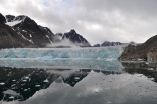(Press-News.org) Chestnut Hill, MA (Aug. 21, 2015) - A fresh look at some old rocks has solved a crucial mystery of the last Ice Age, yielding an important new finding that connects to the global retreat of glaciers caused by climate change today, according to a new study by a team of climate scientists.
For decades, researchers examining the glacial meltdown that ended 11,000 years ago took into account a number of contributing factors, particularly regional influences such as solar radiation, ice sheets and ocean currents.
But a reexamination of more than 1,000 previously studied glacial boulders has produced a more accurate timetable for the pre-historic meltdown and pinpoints the rise in carbon dioxide - then naturally occurring - as the primary driving factor in the simultaneous global retreat of glaciers at the close of the last Ice Age, the researchers report in the journal Nature Communications.
"Glaciers are very sensitive to temperature. When you get the world's glaciers retreating all at the same time, you need a broad, global reason for why the world's thermostat is going up," said Boston College Assistant Professor of Earth and Environmental Sciences Jeremy Shakun. "The only factor that explains glaciers melting all around the world in unison during the end of the Ice Age is the rise in greenhouse gases."
The researchers found that regional factors caused differences in the precise timing and pace of glacier retreat from one place to another, but carbon dioxide was the major driver of the overall global meltdown, said Shakun, a co-author of the report "Regional and global forcing of glacier retreat during the last deglaciation."
"This is a lot like today," said Shakun. "In any given decade you can always find some areas where glaciers are holding steady or even advancing, but the big picture across the world and over the long run is clear - carbon dioxide is making the ice melt."
While 11,000 years ago may seem far too distant for a point of comparison, it was only a moment ago in geological time. The team's findings fix even greater certainty on scientific conclusions that the dramatic increase in manmade greenhouse gases will eradicate many of the world's glaciers by the end of this century.
"This has relevance to today since we've already raised CO2 by more than it increased at the end of the Ice Age, and we're on track to go up much higher this century -- which adds credence to the view that most of the world's glaciers will be largely gone within the next few centuries, with negative consequences such as rising sea level and depleted water resources," said Shakun.
The team reexamined samples taken from boulders that were left by the retreating glaciers, said Shakun, who was joined in the research by experts from Oregon State University, University of Wisconsin-Madison, Purdue University and the National Center for Atmospheric Research in Boulder, Colo.
Each boulder has been exposed to cosmic radiation since the glaciers melted, an exposure that produces the isotope Beryllium-10 in the boulder. Measuring the levels of the isotope in boulder samples allows scientists to determine when glaciers melted and first uncovered the boulders.
Scientists have been using this process called surface exposure dating for more than two decades to determine when glaciers retreated, Shakun said. His team examined samples collected by multiple research teams over the years and applied an improved methodology that increased the accuracy of the boulder ages.
The team then compared their new exposure ages to the timing of the rise of carbon dioxide concentration in the atmosphere, a development recorded in air bubbles taken from ice cores. Combined with computer models, the analysis eliminated regional factors as the primary explanations for glacial melting across the globe at the end of the Ice Age. The single leading global factor that did explain the global retreat of glaciers was rising carbon dioxide levels in the air.
"Our study really removes any doubt as to the leading cause of the decline of the glaciers by 11,000 years ago - it was the rising levels of carbon dioxide in the Earth's atmosphere," said Shakun.
Carbon dioxide levels rose from approximately 180 parts per million to 280 parts per million at the end of the last Ice Age, which spanned nearly 7,000 years. Following more than a century of industrialization, carbon dioxide levels have now risen to approximately 400 parts per million.
"This tells us we are orchestrating something akin to the end of an Ice Age, but much faster. As the amount of carbon dioxide continues to increase, glaciers around the world will retreat," said Shakun.
INFORMATION:
CHICAGO -- Each year, 311 -- New York City's main hub for government information and non-emergency services -- receives millions of requests and complaints, including New Yorkers' gripes about their neighbors.
In a new study from New York University (NYU) using 311 complaint data, researchers tracked when and where New Yorkers complain about their neighbors making noise, blocking driveways, or drinking in public. They found that these complaints -- a defining aspect of urban life -- are more likely to occur in areas sandwiched between two homogenous communities, where ...
A former adviser to the US Secretary of State says that genetic modification (GM) is the most critical technology in agriculture for meeting the challenges of feeding a growing global population, writing in the open access journal Agriculture & Food Security.
Nina Fedoroff, molecular biologist and former Science and Technology Adviser to Hillary Clinton and Condoleezza Rice, warns of the detrimental influence of politics and misinformation on the safety of GM crops. Instead, Fedoroff says that: "GM crops are arguably the safest new crops ever introduced into the human ...
The fact that the greatest diversity of large mammals is found in Africa reflects past human activities - and not climatic or other environmental constraints. This is determined in a new study, which presents what the world map of mammals would look like if modern man (Homo sapiens) had never existed.
In a world without humans, most of northern Europe would probably now be home to not only wolves, Eurasian elk (moose) and bears, but also animals such as elephants and rhinoceroses.
This is demonstrated in a new study conducted by researchers from Aarhus University, Denmark. ...
In a new study published today in the Journal of Health Psychology, researchers from the University of Surrey have found dieters who eat 'on the go' may increase their food intake later in the day which could lead to weight gain and obesity. The findings from the study also showed that eating while walking around triggered more overeating compared to eating during other forms of distraction such as watching TV or having a conversation with a friend.
The team examined 60 females who were either dieters or non-dieters and gave them all a cereal bar to eat under three different ...
A "substantial" proportion of NHS hospital staff--around one in eight, in some places--treat the victims of people trafficking, with maternity services most likely to do so, finds research published in the online journal BMJ Open.
Although understanding of the sorts of health problems trafficked patients are likely to have, is generally high, few NHS staff feel adequately prepared to respond appropriately, the findings suggest.
International law requires that the UK provides victims of human trafficking with whatever medical treatment they require, which includes psychological ...
Nine potentially modifiable risk factors may contribute to up to two thirds of Alzheimer's disease cases worldwide, suggests an analysis of the available evidence, published online in the Journal of Neurology Neurosurgery & Psychiatry.
The analysis indicates the complexity of Alzheimer's disease development and just how varied the risk factors for it are.
But the researchers suggest that preventive strategies, targeting diet, drugs, body chemistry, mental health, pre-existing disease, and lifestyle may help to stave off dementia. This could be particularly important, ...
In a Policy View published in The Lancet Neurology journal, a group of leading experts on the epidemiology of dementia state that the number of people with dementia - both new cases and total numbers with the disease - in some Western European countries is stabilising despite population ageing, in direct contrast to the "dementia epidemic" reported in some recent studies.
The Policy View discusses data from five large epidemiological studies done in Sweden, the Netherlands, the UK, and Spain that compare dementia occurrence in old people across two periods of time using ...
Highlights
Among kidney transplant recipients, patients with mostly IgG3 donor-specific HLA antibodies had a higher likelihood of organ rejection soon after transplantation.
If rejection occurred in those with mostly IgG4 antibodies, it was usually much later after transplantation.
Washington, DC (August 20, 2015) -- The dominant antibody type present in the blood of transplant recipients may indicate their likelihood of experiencing organ rejection, according to a study appearing in an upcoming issue of the Journal of the American Society of Nephrology (JASN). ...
DALLAS, Aug. 20, 2015 -- Caregiver spouses of stroke survivors are at an increased risk of mental and physical health issues that may continue for years, according to research in the American Heart Association journal Stroke.
Swedish researchers evaluated 248 stroke survivors, below age 70 (average mid-sixties), and their spouses at stroke onset and compared the results with 245 non-stroke controls for seven years after the stroke event.
At the seven-year follow-up, 16.5 percent of survivors had suffered a recurrent stroke. Spouses of survivors reported lower scores ...
Boston, MA -- A widely used class of industrial chemicals linked with cancer and interference with immune function--perfluorinated alkylate substances, or PFASs--appears to build up in infants by 20%-30% for each month they're breastfed, according to a new study co-authored by experts from Harvard T.H. Chan School of Public Health. It is the first study to show the extent to which PFASs are transferred to babies through breast milk, and to quantify their levels over time.
"We knew that small amounts of PFAS can occur in breast milk, but our serial blood analyses now show ...


